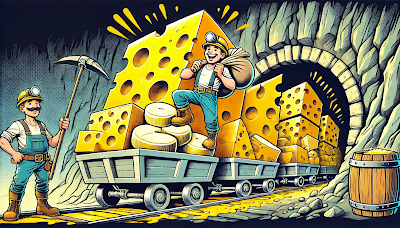#7. There's More Than Gold in Them Hills
It might be fair to say that the United States has a bit of a hoarding problem. From gold to oil to nuclear warheads, we just can’t seem to stop stockpiling everything and anything. One strategic reserve you may not be aware of though is kept just outside of Springfield Missouri, and to us Americans it’s just about as precious as gold—cheese.
[Obligatory Pun Warning!] Let’s peel back the rind on this Fascinating Fact, shall we?
The origins of America’s cheese stockpile can be traced back to the late 1970s, when rising dairy prices and shortages sparked concern. With inflation on dairy products reaching 30%, the government decided to step in. In 1977, President Jimmy Carter initiated a plan to revitalize dairy production, funneling two billion dollars into the industry over the next four years. This policy was designed to stabilize prices and boost supply, a welcome relief for farmers. However, this financial support led to an unforeseen issue—by the early 1980s, the country found itself with a massive surplus of cheese, a byproduct of the overproduction fueled by these subsidies.
As warehouses across the country began to overflow with cheese, the government needed a plan. Key players from the USDA, tasked with managing the dairy surplus, were faced with an unprecedented challenge: how to store millions of pounds of perishable dairy long-term. In a scramble to find a solution, they sought locations that offered both large-scale storage capacity and an environment suitable for preserving dairy products. This search led them to an unexpected yet ingenious solution, one that would keep America’s cheese secure for decades to come. Enter the cheese caves.
These repurposed limestone caves, located just outside Springfield, Missouri, turned out to be an ideal storage facility. Naturally cool and humid, the caves provided the perfect environment for preserving cheese without the need for excessive refrigeration. Their vast underground space could hold billions of pounds of dairy, and they were both secure and cost-effective. This unique combination made the cheese caves the government’s answer to a problem that would have otherwise spoiled, quite literally.
Fast forward to today, and the cheese caves are still in use, quietly housing one of the largest dairy reserves in the world. At any given time, these underground vaults store over a billion pounds of cheese—enough to satisfy even the most ambitious fondue fountain. While the surplus is smaller now than during its peak in the 1980s, the caves remain a crucial part of the U.S. government's dairy safety net. That’s some Gouda information to know, right? I'll just see myself out....

